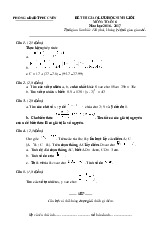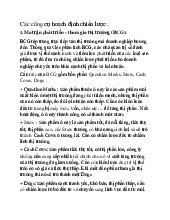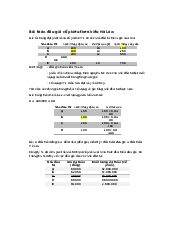


Preview text:
Câu 1: Từ đề bài ta có: a=(m/ Lại có a== Tích phân hai vế ta có: ln(= .t v(t)=2.
Vậy biểu thức vận tốc theo thời gian t.
Câu 2: Ta có: =+ x => v x=1 ; vy=x vx = =1 và vy = = x Xét vx = =1 dx = dt
x(t) = t x(t)2 = t2 (1) Xét vy = = x dy = dt.x Từ (1) y(t) = 2.y(t) = t2 (2)
Từ (1) và (2) ta có: y(t)=
Vậy chất điểm chuyển động theo quỹ đạo parabol.
Câu 3:Ta có : => vx= 3 Lại có : => ax = = -1 . ay = =-0,5 . = => =>
Ta có : tọa độ x đạt cực đại khi cực tiểu và bằng 0, khi đó t=3 Khi t = 3: vx = 0; vy = -1,5
Khi đó vận tốc của hạt là .
Câu 4: Ta có: . dv = (2 – 8x)dt
dv = (2 – 8x) v.dv = (2 – 8x)dx v 2 2 x = 4x – 8x
Vận tốc vx đạt giá trị cực đại x = 0,25 (m)
Câu 5: Ta có : β = = dv = βRdt v(x) = βRt.
Lại có lúc t=1 (s) thì chất điểm có vận tốc v=4 (m/s) Khi đó :R = =2 (m)
Vậy bán kính đường tròn R = 2(m) Câu 6:
a) The average speed between t= 2s and t= 5s is: vtb= b) v(t) = (m/s)
The instantaneous speed at t= 2s and t= 5 is :
At t = 2s: vtt = |-2.2+2| = 2 (m/s)
At t = 5s: vtt = |-2.5 +2| = 8(m/s)
c) The average acceleration between t= 2s and t =5s is: a 2 tb = (m/s ) d) a(t) = (m/s2)
=> Both t = 2s and t = 5s the instantaneous acceleration is att = - 2 (m/s)
e) The object is at rest when v(t) = 0 -2t +2 = 0 t = 1(s)
=> The object is at rest at t = 1(s) Câu 7: x(t)
a) The position of the partical at t = 5 is : x (5) = -73 (m)
b) the partical changes direction when v = 0; t = 4/3 (s)
Its position when it changes direction : x (4/3) = 86/27 (m) c) At t = 0 , xi = 2m
The partical returns to xi = 2m again at :x(t) = = 0 t = 2(s)
At t = 2(s), its velocity is: v (2) = -4 (m/s).



